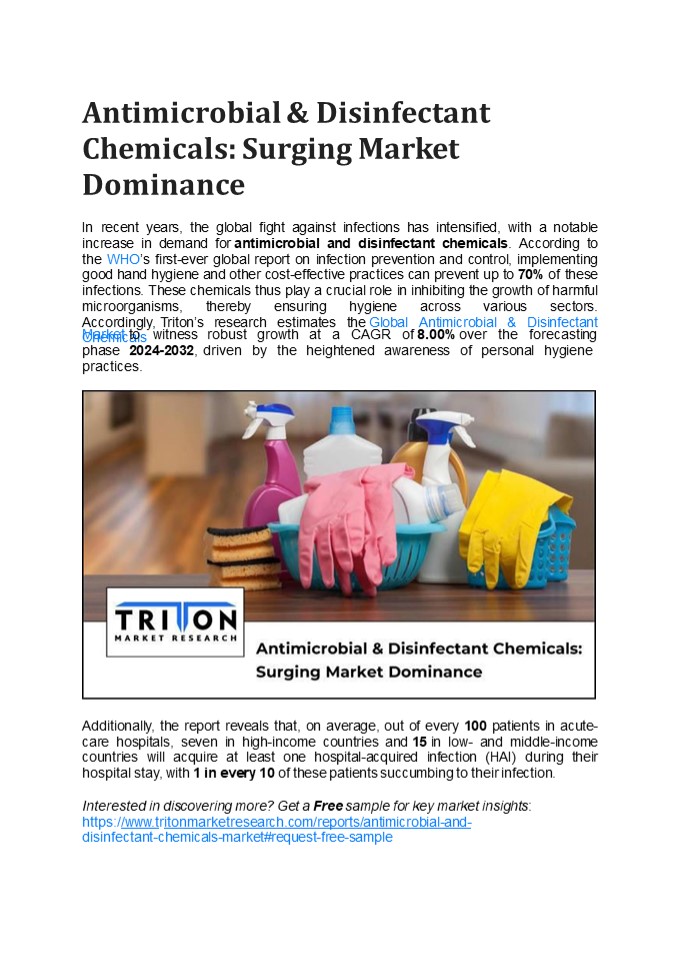Antimicrobial & Disinfectant Chemicals: Surging Market Dominance PowerPoint PPT Presentation
Title: Antimicrobial & Disinfectant Chemicals: Surging Market Dominance
1
Antimicrobial Disinfectant Chemicals Surging
Market Dominance In recent years, the global
fight against infections has intensified,
with a notable increase in demand for
antimicrobial and disinfectant chemicals.
According to the WHOs first-ever global report
on infection prevention and control, implementing
good hand hygiene and other cost-effective
practices can prevent up to 70 of these
infections. These chemicals thus play a crucial
role in inhibiting the growth of harmful
microorganisms, thereby ensuring hygiene
across various sectors. Accordingly,
Tritons research estimates the Global
Antimicrobial Disinfectant Chemicals
Market to witness phase 2024-2032, practices.
robust growth at a CAGR of 8.00
over the forecasting driven by the
heightened awareness of personal hygiene
Additionally, the report reveals that, on
average, out of every 100 patients in acute- care
hospitals, seven in high-income countries
and 15 in low- and middle-income countries
will acquire at least one hospital-acquired
infection (HAI) during their hospital stay,
with 1 in every 10 of these patients succumbing
to their infection. Interested in discovering
more? Get a Free sample for key market insights
https//www.tritonmarketresearch.com/reports/antim
icrobial-and-
disinfectant-chemicals-marketrequest-free-sample
2
- Antimicrobial Disinfectant Chemicals Market
Key Product Types - Antimicrobial additives and disinfectants are
critical in the fight against pathogens.
Among them, antimicrobial disinfectant sprays
and antiseptic soaps stand out for their
widespread use and effectiveness. Antimicrobial
additives are experiencing significant growth,
driven by increasing demand across various
end-use industries such as healthcare,
packaging, food beverage, and construction. - These additives are incorporated into products
during manufacturing to provide long- lasting
protection against bacteria, mold, and fungi,
with silver ions and copper being the most
commonly used due to their broad-spectrum
efficacy and safety. - On the other hand, disinfectants and
sanitizers, such as alcohols, chlorine
compounds, and quaternary ammonium
compounds, are favored for surface
cleaning due to their potent antimicrobial
activity and quick action. - Notable company initiatives associated with these
product types Include - In May 2021, Avient introduced three unique
Thermoplastic Elastomer (TPE) compositions with
antimicrobial additives to its GLSTM TPE
range to limit bacterial development and resist
fungal and mold growth. - In December 2020, Polygiene acquired Addmaster
Holdings Ltd to provide antimicrobial
additives for hard surfaces, marking a
partnership aimed at expanding the use of
antimicrobial technologies. - Clorox Company partnered with Cleveland Clinic
and CDC in March 2021 to offer disinfectant
sprays and best practices for cleaning and
disinfecting across North America, thereby
expanding its consumer base. - In March 2022, the PURELL Brand launched hand
sanitizer solutions like PURELL Advanced
Hand Sanitizer Naturals Foam and PURELL
Advanced Hand Sanitizer 2in1 Moisturizing
Foam, naturally fragranced with essential
oils. - Sotera Health acquired Biosciences Laboratories
in March 2021 to multiply its antimicrobial and
antiviral testing abilities.
a range of materials. For instance, modern
iodophors have been formulated to
3
provide a sustained release of iodine, ensuring
prolonged antimicrobial activity with minimal
skin irritation. Similarly, advancements in
nitrogen compounds, including quaternary
ammonium compounds, have led to the creation
of products that are more effective
against a broader range of pathogens and safer
for human contact. Companies like Ecolab and
Diversey are at the forefront, introducing
cutting-edge antimicrobial cleaning products.
Their latest product launches, such as
hospital- grade disinfectant sprays and soaps,
incorporate these technological
advancements. Looking Ahead Opportunities
Beyond Healthcare While the healthcare sector
remains a primary consumer, the food and
beverage (FB) industry, along with
public facilities, has also significantly
benefited from antimicrobial disinfectants. In
FB, antimicrobial additives ensure food safety
by preventing the growth of bacteria during
processing and storage. In public spaces,
the use of advanced disinfectants helps
in maintaining a hygienic environment,
thus preventing the spread of infections. Besides
, the integration of nanotechnology and
biotechnology in creating next- generation
antimicrobials offers a promising avenue
for innovation. Investment opportunities
are particularly notable in areas focusing
on the development of non- toxic,
biodegradable disinfectants. Thus, these
developments are set to create a huge
investment pocket for players in the
antimicrobial disinfectant chemicals
market. Explore our latest release for the
2024-2032 market analysis https//www.tritonmarke
tresearch.com/pressrelease-details/antimicrobial-
and-disinfectant-chemicals-market-trends
FAQs Q1) What makes antimicrobial disinfectant
sprays more effective than traditional cleaning
products? A Antimicrobial disinfectant
sprays are formulated to inhibit the
growth of microorganisms, offering a higher
level of protection against bacteria and
viruses compared to regular cleaning
products. Q2) Can antimicrobial additives be
used in all types of products? A Yes,
antimicrobial additives can be integrated
into a wide range of products, including
plastics, textiles, and coatings, to provide
continuous protection against microbial growth.

